m (Please, edit at whim, down to a Muppet specific bio. I'll be eventually adding in content on her involvement in the Muppets, from the Academy content of her, on Google Video.) |
BradFraggle (talk | contribs) |
||
| (26 intermediate revisions by 13 users not shown) | |||
| Line 1: | Line 1: | ||
| + | [[Image:JoanandElmo.jpg|thumb|300px|Cooney and Elmo (2005)]] |
||
| ⚫ | '''Joan Ganz Cooney''' (born |
||
| + | [[Image: Joan2.jpg|thumb|300px|Cooney with Big Bird and Elmo]] |
||
| − | |||
| + | [[File:Jgc_random_house_01_sized.jpg|thumb|300px|Cooney signing a contract with [[Random House]] in 1984.]] |
||
| − | Cooney was inducted into the [[National Women's Hall of Fame]] in 1998. |
||
| ⚫ | |||
| − | |||
| − | She is currently married to [[Peter Peterson|Peter G. Peterson]] and lives in New York. |
||
==Childhood== |
==Childhood== |
||
| − | Cooney was born Joan Ganz, and adopted the name Joan Redden Ganz, using her mother's maiden name. Cooney |
+ | Cooney was born Joan Ganz, and adopted the name Joan Redden Ganz, using her mother's maiden name. Cooney went to public school in first grade, switching to Catholic school St. Francis Xavier in Phoenix for grades 2-8. She describes herself then as "just a grim, overwrought little kid." Never able to keep up with her siblings, she always read, much to the chagrin of her mother, who wanted her to get outside. |
| ⚫ | For high school, Cooney went to North Phoenix, while her siblings went to St. Mary's. She feels this separation, that she was no longer "their little sister," let her come into her own. A participant in school plays and even state-wide drama contests, Cooney was sure she wanted to become an actress. She describes herself as the "world's happiest adolescent," especially after not being a happy child. She says that a psychologist once told her "You're the only patient I've ever had that's ever had a happy adolescence." |
||
| − | Cooney's mother and father dated for five years. She describes her father as "the perennial bachelor", being thirteen years older than her mother. |
||
| ⚫ | One teacher in 1943, Bud Brown, taught a course on the history of culture, as well as operating Bud Brown Barn, a dancing establishment. Brown was Cooney's first teacher to talk about the injustice of segregation, and it "absolutely inflamed" her. Brown talked about Hitler's treatment of the Jews, a topic Cooney says "nobody talked about." "I was 13 years old, and it totally changed my life." |
||
| − | Her father, Sylvan, always had a job in the Depression era, and the family had a summer cabin "up near [[Prescott, Arizona]], because the weather was terrible in the summer." Growing up near the Phoenix Country Club, she grew up more affluent than her family had money, although she considers them to have been middle class. Her father's occupation was executive vice-president of the [[First National Bank]] in Phoenix. |
||
| + | Cooney attended the Catholic girls institution Dominican College, before transferring to the University of Arizona, where she obtained her BA in Education. |
||
| − | Cooney went to public school in first grade, switching to Catholic school St. Francis Xavier in Phoenix for grades 2-8. She describes herself then as "just a grim, over-rought little kid". Never able to keep up with her siblings, she always read, much to the chagrin of her mother, who always wanted her to get outside. While she doesn't consider herself to have been a nerd as child, she always argued about ideas, including religion with [[Jesuit]] priests. |
||
| − | |||
| − | As [[World War II]] and [[gas rationing]] came, Cooney's family sold the cottage. Cooney describes the weather at the time as "bearable", thanks to early, self-made [[air conditioning]] systems. |
||
| − | |||
| ⚫ | For high school, Cooney went to North Phoenix, while her siblings went to St. Mary's. She feels this |
||
| − | |||
| ⚫ | One teacher in 1943, Bud Brown, taught a course on the history of culture, as well as operating Bud Brown Barn, a dancing establishment. Brown was Cooney's first teacher to talk about the injustice of segregation, and it "absolutely inflamed" her. Brown talked about Hitler's treatment of the |
||
| − | |||
| − | She stopped acting in college, when her father expressed that he would never support such a career; she says she's very content with this life path, instead of trying to find jobs on [[Broadway theatre|Broadway]]. Cooney attended the Catholic girls institution [[Dominican College]], before transfering to the [[University of Arizona]], where she obtained her BA in Education. Along with not wanting to stay in an all-girls institution, she switched because it was "more fun" at Arizona. She feels she learnt more at Dominican, simply because she didn't find Education challenging. Her mother advised her to take Education, primarily because women whose husband die could work, and be at home with the kids when their home. |
||
| − | |||
| − | Out of college, she went with a friend to [[Washington, D.C.]] to work for the United States government in 1951, organizing Foreign Student Exchange for the State Department. She started as a clerk typist, and was going to be elevated up to the position of Program Officer, upon when she left. During that period, Cooney visited New York City a couple of times, and became intent on moving there. |
||
| − | |||
| − | She returned to Phoenix, and began working at the ''[[Arizona Republic]]'' newspaper, getting a job on the women's page, to write wedding stories and the like. As time went on, she got many general assignments. |
||
==Life in New York City== |
==Life in New York City== |
||
| − | Moving to New York City, she was hired in the press department of |
+ | Moving to [[New York City]], following stints in newspaper and government work, she was hired in the press department of RCA. There, she wrote regular releases, on prediction of what television would be like in the future, from shopping for groceries, and color transmissions. |
| − | She met up with the Arizona-born head of a firm that ran publicity at |
+ | She met up with the Arizona-born head of a firm that ran publicity at Pat Weaver's [[NBC]], moving there after eight or nine months at RCA. At NBC, Cooney promoted the daytime drama lineup, consisting of soap operas. As Cooney had started at RCA with a low wage, and transferred within the same company to NBC, her boss wasn't able to raise her income to acceptable levels. He helped Cooney move to publicize ''The US Steel Hour'', which aired on [[CBS]]. |
| − | |||
| − | Cooney became involved in the Democratic reform movement, led by [[Eleanor Roosevelt]], helping them write releases about their activities. Still, she had much time on her hands, promoting a bi-weekly show. She became involved in the ''[[Partisan Review]]'', to help fundraise; the intellectual contributors had great contempt for Cooney, as she was involved with both television and publicity. |
||
==Television production== |
==Television production== |
||
| + | [[Image:Joanganzoldschool.jpg|thumb|300px|Cooney in the 1969 Sesame Street Pitch Reel.]] |
||
| ⚫ | When someone from ''The US Steel Hour'' |
||
| + | [[Image:Joan-ernie-bert.jpg|thumb|300px|Cooney sharing a laugh with Ernie and Bert.]] |
||
| + | [[Image:ErnieJoanGanzCooney.jpg|thumb|300px|Cooney with Ernie.]] |
||
| ⚫ | When someone from ''The US Steel Hour'' left to go to WGBH in Boston, Cooney was shocked to learn that there was a new educational television movement. She instantly knew that she was meant for such an area of broadcasting, "it was like St. Paul on the highway." She wanted to become the publicist for what is now WNET. The head of the station told Cooney he had a publicist, but needed producers. After proving she knew the national issues of the time and pursuing the position through a series of notes, she became a producer for the station. |
||
| ⚫ | Her first program was ''Court of Reason'', where two advocates debated, with an audience of three expert judges. Cooney's first documentary produced was ''Cuba: A Chance at the Beginning''. Through this, she met Tim Cooney, who would become her husband. The first episodes focused on adult literacy programs, teenage program Har U in Harlem, and Martin Doutch's program for four-year-olds in Harlem. Head Start was started within months of the third episode airing, and bought 125 prints of the episode to use for teacher training. |
||
| − | At the station, she had an initial income of USD$9000, down from USD$12000 at US Steel. |
||
| ⚫ | Cooney "gave a little dinner party" in 1966 with her then-husband Tim Cooney, Lloyd Morrisett (Vice President of the Carnegie Corporation) and his wife Mary, and Louis Friedman. Carnegie Corporation had been researching children's education; Morrisett was inspired by Friedman's speaking on how the medium of television had not been properly tapped to educate children. |
||
| − | Her first program was ''[[Court of Reason]]'', where two advocates debated, with an audience of three expert judges. The series was hosted by [[Columbia University]]'s sociologist [[Robert Merton]]. All tapes, including those with notable guests like [[Malcolm X]], are no existant, as tapes were reused. |
||
| ⚫ | Morrisett called Friedman and Cooney over to the Foundation's offices a few days later. During the meeting, Morrisett and Friedman agreed on created a study by channel Thirteen, to investigate what reactions would be to such a program. During the meeting, Morrisett mentioned that Cooney wouldn't be interested in such a project, as she was involved in public affairs programming. Cooney remembers yelling back "Oh yes, I would!" Friedman passed her enthuasiasm off, as he didn't want to lose her from his crew. |
||
| − | One show Cooney produced was called ''[[Cuba: Should America Change Its Policy?]]'' It featured was a roundtable discussion on the topic; guest President Kennedy "virtually declared World War III".<!--r2, 22:00 or so--> The series incidentally debuted the week before the [[Cuban missile crisis]]. |
||
| ⚫ | One day, Tim Cooney and Morrisett were having lunch together on a separate matter. Tim suggested to Joan that he mention the project, and Joan agreed, knowing she would never get involved with Friedman in the way. Morrisett eventually convinced Friedman that he wanted Cooney, who went on a three-month leave of absence from documentary production. Cooney toured the United States and [[Canada]], talking to educators, researchers, and television producers. She wrote a paper based on this study, titled ''The Potential Uses of Television in Preschool Education''. |
||
| ⚫ | Cooney's first documentary produced was '' |
||
| ⚫ | Cooney says that she always knew television could teach, as kids nationwide sang advertisement jingles perfectly from memory, but a paper was needed to make things conclusive and systematic. The paper suggested the basic format of what was to become ''Sesame Street'', along with unused components. The study also motioned for the creation of children's television production company, to be part of channel Thirteen; she couldn't suggest to her employer that such an organization would be independent. Harold Howe, US Commissioner of Education, liked the findings of the report, and the Ford Foundation soon became interested in such a series. |
||
| − | Cooney produced ''[[Poverty, Anti-Poverty, and the World]]'', for which she won a Regional Emmy. The program invited multitudes of poor people into the studio, to confront the bureaucrats about the programming going on at the time. It was the very first "teach-in", a format that became increasingly popular during the [[Vietnam War]]. |
||
| ⚫ | |||
| ⚫ | Cooney "gave a little dinner party" in 1966 with her then-husband Tim Cooney, |
||
| + | [[Image: Joan1.jpg|thumb|300px]] |
||
| ⚫ | Moving to Carnegie, to act and advise independent of Thirteen, Cooney began laying the groundwork for the [[Sesame Workshop|Children's Television Workshop]]. Carnegie hired Linda Gotley to help Cooney write the proposal. Barbara Finnburg and Morrisett would regularly act as funders, every few days trying to find holes in the proposal. During these days, segments like "One of these things is not like the other" were established. |
||
| ⚫ | Despite the insistence of the US Office of Education that there was no money to fund the project, Howe persisted, and insisted the project be classified as a research project. Ford joined funding, as did the Corporation for Public Broadcasting, which was being established just as ''Sesame Street'' was. Between those organizations and Carnegie, $8 million was raised to create a semi-autonomous organization. This organization was established to become completely separate, should they succeed. |
||
| ⚫ | Morrisett called |
||
| − | |||
| ⚫ | One day, Tim Cooney and Morrisett were having lunch together on a |
||
| − | |||
| ⚫ | Cooney says that she always knew television could teach, as kids nationwide sang |
||
| − | |||
| ⚫ | |||
| ⚫ | Moving to Carnegie, to act and advise independent of Thirteen, Cooney began laying the groundwork for the [[Children's Television Workshop]]. Carnegie hired |
||
| ⚫ | |||
| ⚫ | Despite the insistence of the US Office of Education that there was no money to fund the project, Howe persisted, and insisted the project be classified as a research project. Ford joined funding, as did the |
||
| + | Cooney also served as executive producer on ''[[Follow That Bird]]'', the first ''Sesame Street'' film. Cooney later stepped down as president of CTW, but is still involved with the series, currently serving as chair of [[Sesame Workshop]]'s executive committee. |
||
| ⚫ | |||
| + | ==Other== |
||
| − | With Cooney, an assistant, and a secretary, CTW began production on the show. Cooney tried to talk [[George DeSarde]] of [[WCBS]] to come to CTW as producer of the series. Within a few days of being gratiously declined by DeSarde, Cooney received a letter from [[Mike Dann]] of CBS, who eagerly wanted to join as an executive producer. |
||
| + | Cooney was a cofounder of ''wowOwow'', a mature woman's website, along with [[Candice Bergen]], Joan Juliet Buck, [[Whoopi Goldberg]], Judith Martin, Sheila Nevins, Peggy Noonan, Julia Reed, Liz Smith, Lesley Stahl, [[Marlo Thomas]], [[Lily Tomlin]], Jane Wagner, Mary Wells, and Joni Evans. |
||
| + | Her granddaughter's first words were "Big Bird".<ref>Hellman, Peter. "[http://books.google.com/books?id=KOUCAAAAMBAJ&pg=PA48&vq=sesame+street&source=gbs_search_r&cad=1_0#v=onepage&q=sesame%20street&f=false Street Smart]." ''New York Magazine''. November 23, 1987.</ref> |
||
| − | ==Trivia== |
||
| − | * Her mother nicknamed her "Joan A" and "Ganzeebug". |
||
| − | * Her brother Emil Paul Ganz, residing in Coronado, CA, is 3 years old than her, and her sister Sylvia "Sis" Ganz Houle, residing in Scottsdale, AZ, is 19 months older. All were born within three years and three months. |
||
| − | * One of Cooney's father's relatives disappeared in Berlin, and persumably was taken to an [[internment camp]]. |
||
| − | * "We had this very, sort of ideal existance of always being outdoor, virtually, in those days. Very safe area, nice neighborhoods. I do remember unemployed men coming across the backyards to ask for work, or money, or food, which we always did, that you had— one had no fear of strangers in those days it seems so... We always knew these were victims of the Depression, and my mother would give them work, yard work if she had, otherwise money and a sandwich, and they'd be on their way." |
||
| − | * While she does not actively practice religion, or "necessarily believe" in it, her life is "marked by... the best of Christian teachings." |
||
| − | * Her father died in 1956. |
||
| − | == |
+ | ==Interviews== |
| + | *The Academy of Television Arts and Sciences Foundation interviewed Cooney for the Archive of American Television. The interview was posted on [[YouTube]] in 2008. |
||
| ⚫ | |||
| + | <gallery> |
||
| + | Video:Joan Ganz Cooney - Archive Interview Part 1 of 9|Part 1 |
||
| + | Video:Joan Ganz Cooney - Archive Interview Part 2 of 9|Part 2 |
||
| + | Video:Joan Ganz Cooney - Archive Interview Part 3 of 9|Part 3 |
||
| + | Video:Joan Ganz Cooney Interview - Part 4 of 9|Part 4 |
||
| + | Video:Joan Ganz Cooney Interview - Part 5 of 9|Part 5 |
||
| + | Video:Joan Ganz Cooney - Archive Interview Part 6 of 9|Part 6 |
||
| + | Video:Joan Ganz Cooney - Archive Interview Part 7 of 9|Part 7 |
||
| + | Video:Joan Ganz Cooney - Archive Interview Part 8 of 9|Part 8 |
||
| + | Video:Joan Ganz Cooney - Archive Interview Part 9 of 9|Part 9 |
||
| + | </gallery> |
||
| + | *In 2013 she appeared in the [[Germany|German]] documentary ''[[Als die Sesamstrasse nach Deutschland kam]]'' ("When Sesame Street Came to Germany"), talking about the international co-production, and the history of ''Sesame Street'' in general. |
||
| − | ==External links== |
||
| − | {{Wikipedia|Joan Ganz Cooney}} |
||
| − | * {{imdb name|id=0177760|name=Joan Ganz Cooney}} |
||
| − | * [http://video.google.com/videoplay?docid=7191093260486517767&q=Joan+Ganz+Cooney&time=30000 Google Video: Archive of American Television Interview with Joan Ganz Cooney Part 1 of 9], free to view |
||
| + | ==Sources== |
||
| + | <references /> |
||
| ⚫ | |||
[[Category:Producers|Cooney]] |
[[Category:Producers|Cooney]] |
||
| + | [[Category:Sesame Workshop Staff|Cooney]] |
||
Revision as of 03:15, 25 November 2013
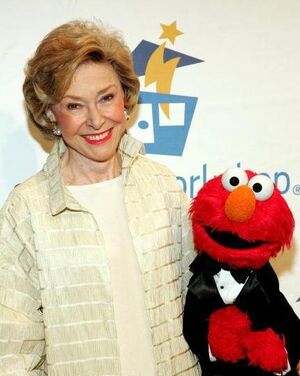
Cooney and Elmo (2005)
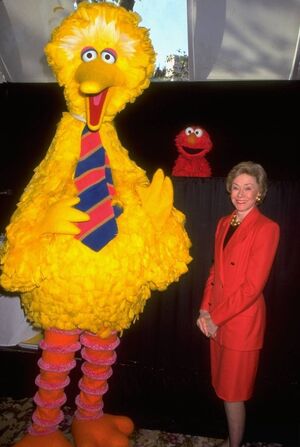
Cooney with Big Bird and Elmo
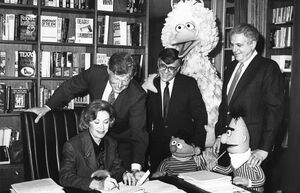
Cooney signing a contract with Random House in 1984.
Joan Ganz Cooney (born November 30, 1929 in Phoenix, Arizona) is one of the founders of the Children's Television Workshop (now known as Sesame Workshop). Cooney received her B.A. degree in education from the University of Arizona in 1951.
Childhood
Cooney was born Joan Ganz, and adopted the name Joan Redden Ganz, using her mother's maiden name. Cooney went to public school in first grade, switching to Catholic school St. Francis Xavier in Phoenix for grades 2-8. She describes herself then as "just a grim, overwrought little kid." Never able to keep up with her siblings, she always read, much to the chagrin of her mother, who wanted her to get outside.
For high school, Cooney went to North Phoenix, while her siblings went to St. Mary's. She feels this separation, that she was no longer "their little sister," let her come into her own. A participant in school plays and even state-wide drama contests, Cooney was sure she wanted to become an actress. She describes herself as the "world's happiest adolescent," especially after not being a happy child. She says that a psychologist once told her "You're the only patient I've ever had that's ever had a happy adolescence."
One teacher in 1943, Bud Brown, taught a course on the history of culture, as well as operating Bud Brown Barn, a dancing establishment. Brown was Cooney's first teacher to talk about the injustice of segregation, and it "absolutely inflamed" her. Brown talked about Hitler's treatment of the Jews, a topic Cooney says "nobody talked about." "I was 13 years old, and it totally changed my life."
Cooney attended the Catholic girls institution Dominican College, before transferring to the University of Arizona, where she obtained her BA in Education.
Life in New York City
Moving to New York City, following stints in newspaper and government work, she was hired in the press department of RCA. There, she wrote regular releases, on prediction of what television would be like in the future, from shopping for groceries, and color transmissions.
She met up with the Arizona-born head of a firm that ran publicity at Pat Weaver's NBC, moving there after eight or nine months at RCA. At NBC, Cooney promoted the daytime drama lineup, consisting of soap operas. As Cooney had started at RCA with a low wage, and transferred within the same company to NBC, her boss wasn't able to raise her income to acceptable levels. He helped Cooney move to publicize The US Steel Hour, which aired on CBS.
Television production
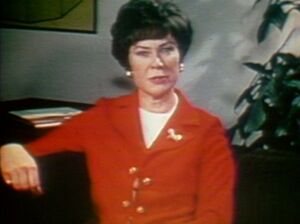
Cooney in the 1969 Sesame Street Pitch Reel.
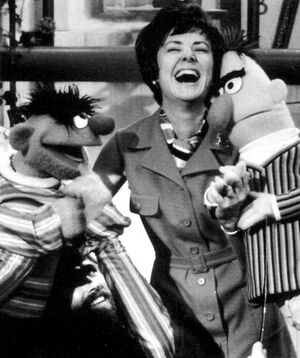
Cooney sharing a laugh with Ernie and Bert.
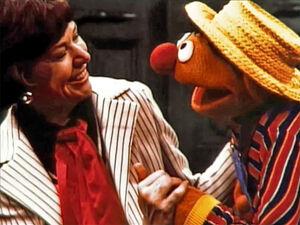
Cooney with Ernie.
When someone from The US Steel Hour left to go to WGBH in Boston, Cooney was shocked to learn that there was a new educational television movement. She instantly knew that she was meant for such an area of broadcasting, "it was like St. Paul on the highway." She wanted to become the publicist for what is now WNET. The head of the station told Cooney he had a publicist, but needed producers. After proving she knew the national issues of the time and pursuing the position through a series of notes, she became a producer for the station.
Her first program was Court of Reason, where two advocates debated, with an audience of three expert judges. Cooney's first documentary produced was Cuba: A Chance at the Beginning. Through this, she met Tim Cooney, who would become her husband. The first episodes focused on adult literacy programs, teenage program Har U in Harlem, and Martin Doutch's program for four-year-olds in Harlem. Head Start was started within months of the third episode airing, and bought 125 prints of the episode to use for teacher training.
Cooney "gave a little dinner party" in 1966 with her then-husband Tim Cooney, Lloyd Morrisett (Vice President of the Carnegie Corporation) and his wife Mary, and Louis Friedman. Carnegie Corporation had been researching children's education; Morrisett was inspired by Friedman's speaking on how the medium of television had not been properly tapped to educate children.
Morrisett called Friedman and Cooney over to the Foundation's offices a few days later. During the meeting, Morrisett and Friedman agreed on created a study by channel Thirteen, to investigate what reactions would be to such a program. During the meeting, Morrisett mentioned that Cooney wouldn't be interested in such a project, as she was involved in public affairs programming. Cooney remembers yelling back "Oh yes, I would!" Friedman passed her enthuasiasm off, as he didn't want to lose her from his crew.
One day, Tim Cooney and Morrisett were having lunch together on a separate matter. Tim suggested to Joan that he mention the project, and Joan agreed, knowing she would never get involved with Friedman in the way. Morrisett eventually convinced Friedman that he wanted Cooney, who went on a three-month leave of absence from documentary production. Cooney toured the United States and Canada, talking to educators, researchers, and television producers. She wrote a paper based on this study, titled The Potential Uses of Television in Preschool Education.
Cooney says that she always knew television could teach, as kids nationwide sang advertisement jingles perfectly from memory, but a paper was needed to make things conclusive and systematic. The paper suggested the basic format of what was to become Sesame Street, along with unused components. The study also motioned for the creation of children's television production company, to be part of channel Thirteen; she couldn't suggest to her employer that such an organization would be independent. Harold Howe, US Commissioner of Education, liked the findings of the report, and the Ford Foundation soon became interested in such a series.
Children's Television Workshop established
Moving to Carnegie, to act and advise independent of Thirteen, Cooney began laying the groundwork for the Children's Television Workshop. Carnegie hired Linda Gotley to help Cooney write the proposal. Barbara Finnburg and Morrisett would regularly act as funders, every few days trying to find holes in the proposal. During these days, segments like "One of these things is not like the other" were established.
Despite the insistence of the US Office of Education that there was no money to fund the project, Howe persisted, and insisted the project be classified as a research project. Ford joined funding, as did the Corporation for Public Broadcasting, which was being established just as Sesame Street was. Between those organizations and Carnegie, $8 million was raised to create a semi-autonomous organization. This organization was established to become completely separate, should they succeed.
At a press conference in March 1968, the Children's Television Workshop and Sesame Street were announced. Jack Gould, television critic for The New York Times gave the project front page space. "If you had Jack Gould in your corner, you could not believe what it meant."
Cooney also served as executive producer on Follow That Bird, the first Sesame Street film. Cooney later stepped down as president of CTW, but is still involved with the series, currently serving as chair of Sesame Workshop's executive committee.
Other
Cooney was a cofounder of wowOwow, a mature woman's website, along with Candice Bergen, Joan Juliet Buck, Whoopi Goldberg, Judith Martin, Sheila Nevins, Peggy Noonan, Julia Reed, Liz Smith, Lesley Stahl, Marlo Thomas, Lily Tomlin, Jane Wagner, Mary Wells, and Joni Evans.
Her granddaughter's first words were "Big Bird".[1]
Interviews
- The Academy of Television Arts and Sciences Foundation interviewed Cooney for the Archive of American Television. The interview was posted on YouTube in 2008.
- In 2013 she appeared in the German documentary Als die Sesamstrasse nach Deutschland kam ("When Sesame Street Came to Germany"), talking about the international co-production, and the history of Sesame Street in general.
Sources
- ↑ Hellman, Peter. "Street Smart." New York Magazine. November 23, 1987.
- "Archive of American Television Interview with Joan Ganz Cooney," an inteview by Shirley Wershba for the Academy of Television Arts & Sciences Foundation.
